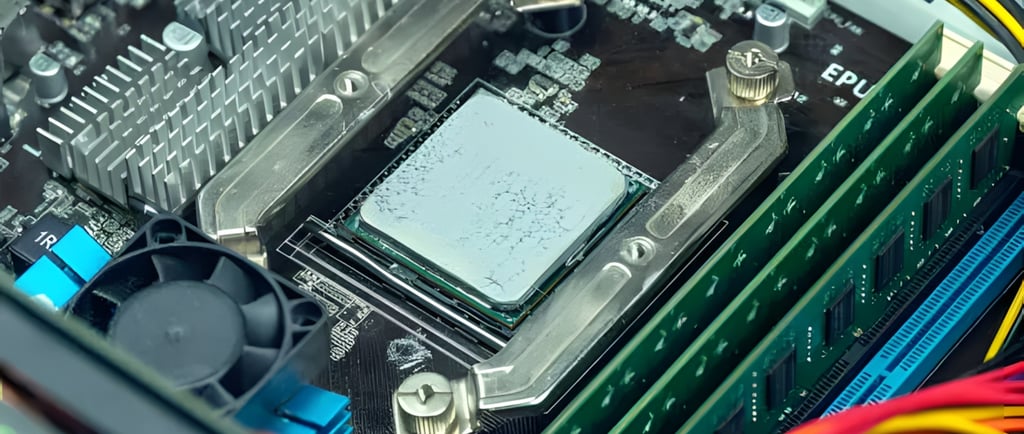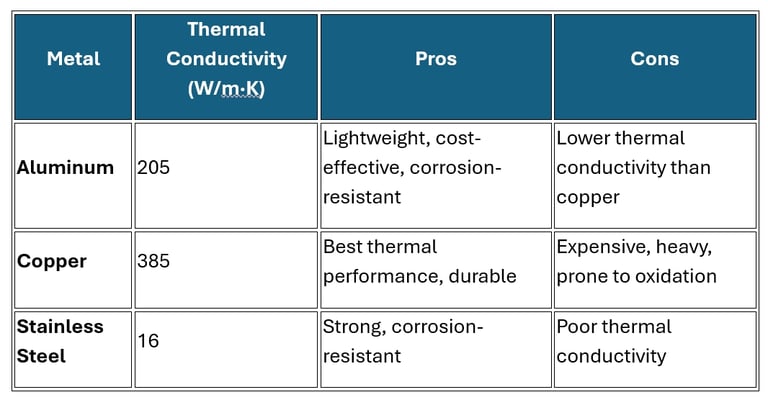Enhancing Thermal Management in Electronics through Metal Fabrication
With today’s high-power processors, compact designs, and growing power densities, traditional cooling methods often fall short. This is where metal fabrication plays a crucial role. By leveraging metal components such as heat sinks, enclosures, and thermal interfaces, manufacturers can significantly enhance heat dissipation and ensure reliable operation.
2/26/20254 min read


If you’ve ever held a laptop that suddenly became too hot to touch or seen a smartphone slow down when running a heavy application, you’ve witnessed firsthand how heat impacts electronic devices. Thermal management is not just about comfort—it directly affects performance, longevity, and even safety.
For engineers and decision-makers in electronics development, keeping devices cool is a top priority. With today’s high-power processors, compact designs, and growing power densities, traditional cooling methods often fall short. This is where metal fabrication plays a crucial role. By leveraging metal components such as heat sinks, enclosures, and thermal interfaces, manufacturers can significantly enhance heat dissipation and ensure reliable operation.
In this article, we’ll explore the importance of thermal management, how metal components improve heat dissipation, key metal fabrication techniques, and practical design considerations to optimize cooling solutions.
1. The Importance of Thermal Management in Electronics
Heat is an unavoidable byproduct of electronic operation. When electrical components work, they generate heat, and if this heat isn’t efficiently dissipated, it can lead to serious consequences:
Performance Issues: Overheating causes processors to throttle performance, reducing speed and efficiency.
Component Degradation: High temperatures accelerate wear and tear on electronic components, shortening their lifespan.
Reliability Risks: Poor thermal management can lead to system failures, malfunctions, and even dangerous overheating incidents.
With the rise of compact consumer electronics, IoT devices, and high-power industrial applications, effective thermal management is now more critical than ever. Simply put, without proper heat dissipation, even the most advanced electronics can fail.
2. How Metal Components Improve Heat Dissipation
One of the most effective ways to manage heat is through metal fabrication. Metals, especially aluminum and copper, have excellent thermal conductivity, allowing them to absorb and dissipate heat efficiently.
Key Metal Components for Thermal Management:
Heat Sinks: Used in everything from CPUs to LED lighting, heat sinks draw heat away from hot components and disperse it into the surrounding air.
Metal Enclosures: Instead of plastic casings, metal enclosures provide better heat dissipation and structural strength.
Thermal Interfaces: Components like metal heat spreaders and vapor chambers further enhance heat transfer between surfaces.
Cooling Plates & Heat Pipes: These advanced solutions help spread heat efficiently across large areas, ideal for high-performance applications.
By incorporating metal into an electronic device’s design, engineers can optimize airflow, increase surface area for cooling, and improve overall heat transfer efficiency.
3. Key Metal Fabrication Techniques for Thermal Solutions
When designing metal-based thermal solutions, choosing the right fabrication method is essential. Different techniques provide unique benefits depending on cost, complexity, and performance requirements.
CNC Machining
CNC machining allows for highly customized, precise heat sinks and cooling components. It’s ideal for low- to medium-volume production where design complexity is high.
Best for: Custom heat sinks, thermal spreaders, and enclosures for high-performance electronics.
Die Casting
Die casting is a cost-effective method for mass-producing metal parts. It’s widely used for aluminum heat sinks and enclosures due to its ability to produce complex shapes efficiently.
Best for: Large-scale production of thermal enclosures and integrated cooling components.
Sheet Metal Fabrication
This method is commonly used for creating lightweight, thermally efficient ventilated enclosures, brackets, and cooling panels.
Best for: Enclosure designs that need built-in airflow for passive cooling.
Extrusion
Extrusion is the go-to method for producing aluminum heat sinks with optimized fin structures to increase surface area.
Best for: Standardized heat sinks and cost-effective passive cooling solutions.
Choosing the right fabrication method is crucial to balancing thermal performance, manufacturing costs, and product reliability.
4. Choosing the Right Metal for Heat Dissipation
Not all metals perform equally when it comes to heat dissipation. Selecting the right material depends on thermal conductivity, weight, cost, and application needs.
Comparison of Common Metals for Thermal Management:


For most applications, aluminum is the preferred choice due to its balance of thermal performance, weight, and cost. However, copper is unbeatable for applications demanding maximum heat dissipation, such as high-end GPUs and industrial power systems.
5. Design Considerations for Effective Thermal Management
Optimizing thermal management involves more than just choosing the right materials—it requires smart design choices. Here are some key considerations:
Maximize Surface Area: The more surface area exposed to air, the better the cooling. Heat sink fins should be optimized for airflow.
Use Thermal Interface Materials (TIMs): Thermal pastes, pads, and adhesives improve heat transfer efficiency between metal components and heat sources.
Optimize Airflow: Proper ventilation, fan placement, and heat sink orientation prevent heat buildup.
Combine Materials Strategically: Hybrid designs, such as aluminum heat sinks with copper heat pipes, enhance cooling while keeping weight and cost manageable.
Engineers must balance thermal performance with manufacturing feasibility, cost, and device form factor to ensure reliable, scalable solutions.
6. Innovations and Future Trends in Metal-Based Thermal Management
The demand for efficient cooling is pushing innovation in metal-based thermal solutions. Some emerging trends include:
High-Performance Metal Alloys
New aluminum-copper composite alloys are being developed to offer the best of both worlds—high thermal conductivity at a lower cost and weight.
Liquid Cooling Systems with Metal Heat Exchangers
Industries like AI, data centers, and electric vehicles (EVs) are moving towards liquid-cooled metal plates and microchannel heat exchangers for superior cooling efficiency.
Advanced Manufacturing Techniques
3D printing of metal heat sinks is gaining traction, enabling complex, lightweight designs that were previously impossible.
Phase-change cooling materials integrated into metal enclosures improve passive heat dissipation.
As electronic devices become smaller, faster, and more powerful, metal fabrication will remain at the forefront of thermal management solutions.
Conclusion
Effective thermal management is no longer an afterthought—it’s a critical factor in the success of modern electronic devices. By leveraging metal components such as heat sinks, enclosures, and cooling plates, designers and decision-makers can dramatically improve heat dissipation and device longevity.
With the right combination of materials, fabrication techniques, and smart design choices, companies can achieve high-performance cooling solutions that keep electronics running efficiently and reliably. As technology evolves, metal fabrication will continue to be a game-changer in the quest for better thermal management.
Are you exploring thermal solutions for your next electronic product? Consider integrating advanced metal fabrication techniques to ensure your device stays cool under pressure!
